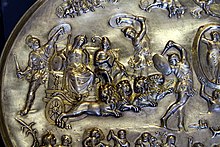

The Parabiago plate, also known as the Parabiago patera,[a] is an ancient Roman circular silver plate depicting mythological figures. It was found in an ancient Roman cemetery at Parabiago, near Milan, in 1907,[1] and is now in the Archaeological Museum of Milan. The plate depicts Cybele with her consort Attis in a "vast cosmic setting"[2] amid "sun, moon, earth and sea, time and the seasons."[3] At the time of its discovery, it was thought to have been used as a lid for a funerary amphora.[4]
The plate is difficult to date. Earlier scholars tended to date it to the 2nd century CE, because of its classicizing style, but stylistic characteristics also permit a later date. Technical analyses, however, support a provenance in the 4th–5th centuries, even though it bears little stylistic resemblance to other silver pieces from that period.[1]
Cite error: There are <ref group=lower-alpha> tags or {{efn}} templates on this page, but the references will not show without a {{reflist|group=lower-alpha}} template or {{notelist}} template (see the help page).
- ^ a b Cite error: The named reference
Leader-Newby-2004was invoked but never defined (see the help page). - ^ Cite error: The named reference
Gasparro-1985was invoked but never defined (see the help page). - ^ Cite error: The named reference
Ferguson-1970-1985was invoked but never defined (see the help page). - ^ Cite error: The named reference
Cook-1940-2010was invoked but never defined (see the help page).